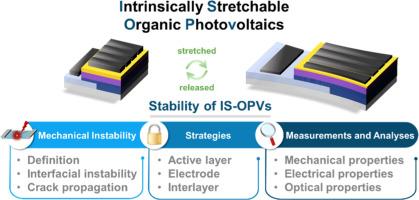本征可拉伸聚合物光伏技术的稳定性:基础、成就与展望
IF 26.1
1区 化学
Q1 POLYMER SCIENCE
引用次数: 0
摘要
作为可穿戴电子系统的理想电源,可拉伸有机光伏技术近来备受关注。尤其是对本征可拉伸有机光伏器件(IS-OPVs)的研究已经加速,因为 IS-OPVs 的独特优势在于其固有的可变形性,而这并不取决于制造工艺或预处理方法。值得注意的是,光活性面积在拉伸过程中会增加,这表明功率输出可以提高,从而突出了其作为自供电电子系统电源的优势。尽管 IS-OPV 实现了高功率转换效率和可拉伸性,但在市场应用方面仍面临挑战。IS-OPV 最关键的性能因素是稳定性,它能确保在机械应力下稳定运行。本综述分析了降低 IS-OPV 稳定性的结构因素。由于 IS-OPV 具有多层结构,机械故障可能由各种复杂原因造成,因此调查和全面了解导致性能下降的因素变得更加复杂。本综述介绍并讨论了最近开发的提高 IS-OPV 机械稳定性的工程策略。此外,本综述还总结了评估 IS-OPV 性能的实验方法,并讨论了从这些实验中获得的有关制造性能更稳定的 IS-OPV 的见解。本文章由计算机程序翻译,如有差异,请以英文原文为准。

Stability of Intrinsically Stretchable Polymer Photovoltaics: Fundamentals, Achievements, and Perspectives
Stretchable organic photovoltaics have recently garnered significant attention as promising power sources for wearable electronic systems. Especially, research on intrinsically stretchable organic photovoltaics (IS-OPVs) has been accelerated, as the unique advantage of IS-OPVs is their inherent deformability, which does not depend on fabrication processes or pre-treatment methods. Remarkably, the photoactive area increases during stretching, indicating a potential increase in power output and underscoring IS-OPV's strengths as a power source in self-powered electronic systems. Despite rapid advancements in power conversion efficiency and stretchability, IS-OPVs still encounter challenges in market adoption. The most critical performance factor for IS-OPVs is stability, which ensures stable operation under mechanical stress. This review analyses the structural factors that degrade the stability of IS-OPVs. Given their multilayer structure, mechanical failure can result from various complex causes, thus complicating the investigation and comprehensive understanding of the factors that promote performance degradation. This review introduces and discusses recently developed engineering strategies aimed at improving the mechanical stability of IS-OPVs. Furthermore, this review summarizes various experimental methods to assess the performance of IS-OPVs and discusses the insights gained from these experiments in relation to fabricating mechanically stable IS-OPVs with enhanced performance.
求助全文
通过发布文献求助,成功后即可免费获取论文全文。
去求助
来源期刊

Progress in Polymer Science
化学-高分子科学
CiteScore
48.70
自引率
1.10%
发文量
54
审稿时长
38 days
期刊介绍:
Progress in Polymer Science is a journal that publishes state-of-the-art overview articles in the field of polymer science and engineering. These articles are written by internationally recognized authorities in the discipline, making it a valuable resource for staying up-to-date with the latest developments in this rapidly growing field.
The journal serves as a link between original articles, innovations published in patents, and the most current knowledge of technology. It covers a wide range of topics within the traditional fields of polymer science, including chemistry, physics, and engineering involving polymers. Additionally, it explores interdisciplinary developing fields such as functional and specialty polymers, biomaterials, polymers in drug delivery, polymers in electronic applications, composites, conducting polymers, liquid crystalline materials, and the interphases between polymers and ceramics. The journal also highlights new fabrication techniques that are making significant contributions to the field.
The subject areas covered by Progress in Polymer Science include biomaterials, materials chemistry, organic chemistry, polymers and plastics, surfaces, coatings and films, and nanotechnology. The journal is indexed and abstracted in various databases, including Materials Science Citation Index, Chemical Abstracts, Engineering Index, Current Contents, FIZ Karlsruhe, Scopus, and INSPEC.
 求助内容:
求助内容: 应助结果提醒方式:
应助结果提醒方式:


